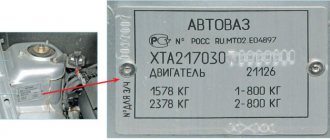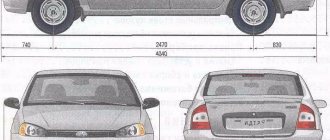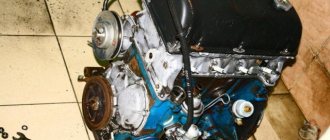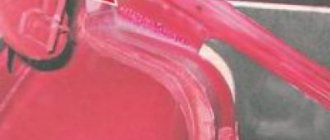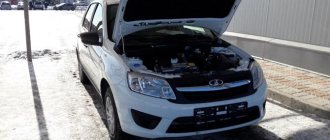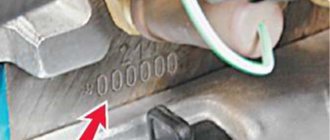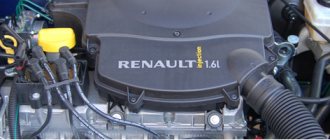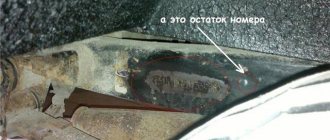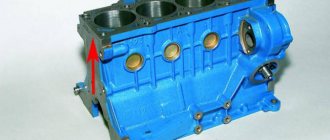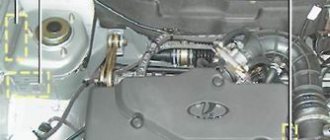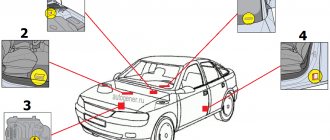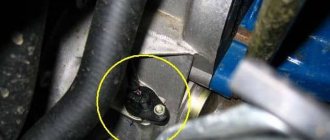No information can classify the power plant as well as the engine number of the Lada Kalina. This simple invention is able to recognize a released product among millions of other motors and reveal the ins and outs of the engine. A driver who correctly uses the available information is protected and will avoid trouble.
It is important to know where to look for the applied marker. The knowledge gained will not be a burden; on the contrary, it will help when buying a used car. In addition, they will allow the user to control government officials during the routine inspection procedure or vehicle registration.
Lada Kalina:
Lada Kalina
Lada Kalina is a family of Russian passenger cars in the upper class “B” segment according to the European classification .
The history of "Kalina" - the same people's car from the ever-memorable ABVA concern - begins in 1993. These machines were once going to be made at ABBA’s own plant, so they were designed without regard to existing conveyors and technological processes.
But either they collected little money, or they miraculously disappeared, but the life of the new car did not work out.
However, the interesting development did not die, but moved under the roof of VAZ, fortunately, its specialists created the car. But now Kalina had to adapt to the existing production. They tried to preserve its appearance as much as possible, and the design was unified with the Samara and Tens platforms.
In 1998, the designed car was named Lada Kalina. Prototypes were demonstrated in 1999 - a hatchback and in 2000 - a sedan.
Production of sedan cars began on November 18, 2004. On July 21, 2006, assembly of the Lada Kalina hatchback began, and on August 4, its first sale took place. In July 2007, production of LADA Kalina with a new 1.4-liter engine began, and in September of the same year, production of commercial LADA Kalina with ABS began.
In August, the first Lada Kalina sedan of export configuration was also released. At the same time, however, due to a defect in the steering column, 6,200 cars produced in December 2005 - January 2006 had to be recalled. They were repaired by the OJSC dealer. AvtoVAZ recalled 171 cars of the Lada Kalina model, which were produced on May 24 - 25, 2006. The concern of the plant specialists was caused by a defect in the casting of the steering gear housing. In addition, AvtoVAZ recalled 8.4 thousand Lada Kalina cars due to defects in engine mounts. Considering the total volume of cars of this brand sold by the car plant, it turns out that more than 80% of Lada Kalina cars produced by the plant in 2006 contained defects.
Over two years, 80,000 cars were assembled, the daily assembly rate was 335 units.
In May 2007, while visiting AvtoVAZ, Vladimir Putin, then President of Russia, took a Lada Kalina for a test drive on a test track. According to him, he managed to reach speeds of up to 120 kilometers per hour.
The main purpose of the family is suburban-urban use. Hence the higher seating position and everything that comes with it: wide-opening doors, a small but comfortable trunk, electric power steering. In addition, a roof rack and a towbar are provided.
Modern requirements for passive safety have resulted in developed thresholds to withstand side impacts, jumpers between the thresholds, and bars in the doors. As a result, the car turned out to be quite heavy, no lighter than the “ten”.
We must pay tribute to the Novolipetsk Metallurgical Plant, which mastered for the LADA 1118 KALINA car steel without introducing atoms for hot-dip galvanizing, which had not previously been produced in Russia. Severstal has achieved the required surface quality on a large range of parts. Lysvensky Metallurgical Plant reconstructed virtually all lines for electrolytic galvanizing. The Magnitogorsk Iron and Steel Works has installed a reversing mill and a modern hot-dip galvanizing line. In the body of the LADA 1118 KALINA there is 35% hot-dip galvanized steel, 13% electro-galvanized steel, 12% high-strength steel, first mastered and used. The remaining 40% is uncoated sheet steel from NLMK, Severstal and MMK.
Welding required the reconstruction of welding lines for the LADA 110 car, as well as the use of double-sided electrodes on the mounted welding line for the LADA 1118 Kalina car, increasing the welding current and its automatic regulation. The result was worth the effort. If the VAZ 2101 car had more than 500 parts and about 10 thousand welding points, then the LADA 1118 Kalina used about 350 parts. To connect them, 4.5 thousand welding points were required, that is, there were more than half as many of them. This means that a new car has at least half as many points of possible corrosion, and much less labor is required for welding.”
Overpriced minimalism?
Now I want to share my impressions about what I absolutely didn’t like about the 2nd generation Kalina and why AvtoVAZ is going back to the past again?
- Firstly, once again I want to emphasize that the electric headlight adjustment has been made hydraulic again. Am I the only one who finds this illogical and incomprehensible? It seems that the car model is new, but the technology is a hundred years old.
- Why are there no full front fender liners, even on the most expensive configuration for 452,600 rubles? For some reason, they were previously installed even in the cheapest configuration. Moreover, they were made of very high quality with absolutely zero gaps between the wing and the fender liners themselves. The new model is a pathetic parody of what was on the previous version.
- Although the trunk now opens from inside the car, it closes simply badly. You have to slam the lid so hard that you feel uncomfortable.
- I think many owners of the previous Kalina are familiar with the problem with the rear doors being difficult to open. So, I want to disappoint potential buyers of the new product. Even brand new cars that are in the showroom have this problem. I checked everything today. Of the four doors, only 2 opened normally. By the way, one more thing: the doors on my “old” car close much better. Here you have to apply much more effort.
What would I like to say in conclusion of my acquaintance with Kalina-2nd generation. Well, if we take into account the “standard” or “norm” package, then it’s a completely normal car for the money. I am especially pleased with the changes in interior and exterior design. Of course, the engineers thought about safety; now even the driver’s airbag will be present in the base. Of course, I would like to see the quality of materials and workmanship at a higher level, and all sorts of minor defects could also be corrected, which were mentioned above.
Below in the gallery I have posted several photographs that I managed to take at the car showroom. You can once again look at the living “Berry” of the second generation.
Models
- The sedan is the very first base model. The export version of the model (LADA-1118) is equipped with driver and passenger airbags and complies with Euro-4 standards (vehicles that currently meet the Euro-3 standard are supplied to the domestic market).
- Hatchback - (export name - LADA-1119).
- Station wagon - produced since 2008. Export name - LADA-1117.
Where is the Lada Priora engine number?
This information interests people for a reason. The fact is that this data is often needed when stopped by traffic police officers. They often require this information and also ask to show where the number is located in order to verify the identity of the data in reality and in the technical passport. When buying a car on the secondary market, this information is also needed. It happens that a car is listed as stolen, and if you purchase it, you may have serious problems. To avoid this, you need to know the engine number of your iron horse.
Items that can be used to find the number:
- instructions for use;
- technical certificate;
- lighting device.
Using these tools, you can find out what engine number your car has.
Specifications
LADA-1118 Lada Kalina (sedan)
| Modifications with engine | 1.6 l. 8th grade (Euro-3) | 1.4 l. 16 classes (Euro-3) | ||
Body | ||||
| Length, mm | 4040 | 4040 | ||
| Width, mm | 1700 | 1700 | ||
| Height, mm | 1500 | 1500 | ||
| Front wheel track, mm | 1430 | 1430 | ||
| Rear wheel track, mm | 1410 | 1410 | ||
| Luggage compartment volume, cubic meters dm. | 400 | 400 | ||
| Weight in running order, kg | 1080 | 1080 | ||
| Gross vehicle weight, kg | 1555 | 1555 | ||
| Wheel formula / drive wheels | 4 x 2 / front | 4 x 2 / front | ||
| Body type / number of doors | sedan / 4 | sedan / 4 | ||
Engine | ||||
| engine's type | injection petrol | injection petrol | ||
| Supply system | distributed injection with electronic control | distributed injection with electronic control | ||
| Engine displacement, cubic meters cm | 1596 | 1390 | ||
| Maximum power, kW/rpm. | 59,5 / 5200 | 65,5 / 5250 | ||
| Maximum torque, Nm at rpm | 120 / 2500-2900 | 127 / 4200-4800 | ||
| Fuel | AI-95 (min) | AI-95 (min) | ||
| Fuel consumption (combined cycle), l/100 km | 7,8 | 7,0 | ||
| Maximum speed, km/h | 160 | 165 | ||
Transmission | ||||
| Transmission | mechanical | mechanical | ||
| Number of gears | 5 forward, 1 reverse | 5 forward, 1 reverse | ||
Other | ||||
| Steering | with electromechanical amplifier | with electromechanical amplifier | ||
| Tires | 175/70R13 80T,82T,H 5Jx13; 175/65R14 82H 5Jx14; 185/60R14 82H 5.5Jx14 | 175/70R13 80T,82T,H 5Jx13; 175/65R14 82H 5Jx14; 185/60R14 82H 5.5Jx14 | ||
| Fuel tank capacity, l | 50 | 50 | ||
Specifications
LADA-1119 Lada Kalina (hatchback)
| 1.6 l. 8th grade (Euro-3) | 1.4 l. 16 classes (Euro-3) | |
| Length, mm | 3850 | 3850 |
| Width, mm | 1700 | 1700 |
| Height, mm | 1500 | 1500 |
| Base, mm | 2470 | 2470 |
| Front wheel track, mm | 1430 | 1430 |
| Rear wheel track, mm | 1410 | 1410 |
| Luggage compartment volume, cubic meters dm. | 235 | 235 |
| Weight in running order, kg | 1080 | 1080 |
| Gross vehicle weight, kg | 1555 | 1555 |
| Permissible total weight of a towed trailer with brakes, kg | 900 | 900 |
| Permissible total weight of a towed trailer without brakes, kg | 450 | 450 |
| Wheel formula / drive wheels | 4 x 2 / front | 4 x 2 / front |
| Car layout diagram | front-wheel drive, front engine, transverse | front-wheel drive, front engine, transverse |
| Body type / number of doors | hatchback / 5 | hatchback / 5 |
| engine's type | gasoline, four-stroke | gasoline, four-stroke |
| Supply system | distributed injection with electronic control | distributed injection with electronic control |
| Number and arrangement of cylinders | 4, in-line | 4 in a row |
| Engine displacement, cubic meters cm | 1596 | 1390 |
| Maximum power, kW/rpm. | 59,5 / 5200 | 65.5/5250 |
| Maximum torque, Nm at rpm | 120 / 3000 | 127/4200-4800 |
| Fuel | unleaded gasoline AI-95 (min) | unleaded gasoline AI-95 (min) |
| Fuel consumption by driving cycle, l/100 km | 7,8 | 7,0 |
| Maximum speed, km/h | 170 | 165 |
| Transmission | with manual control | with manual control |
| Number of gears | 5 forward, 1 reverse | 5 forward, 1 reverse |
| Main gear ratio | 3,7 | 3,7 |
| Steering | with electromechanical amplifier, rack and pinion steering mechanism | with electromechanical amplifier, rack and pinion steering mechanism |
| Transfer case | ||
| Number of RK transmissions | ||
| Tires | 175/70 R13 (80, 82, T,H); 175/65 R14 (82, H); 185/60 R14 (82, H) | 175/65 R14 (82, H); 185/60 R14 (82, H) |
| Fuel tank capacity, l | 50 | 50 |
Location of the engine number on the VAZ-2112
It happens that unknowing car enthusiasts are able to spend more than one hour under the hood of a car looking for the required identification number. The thing is that during operation, some of them can become covered with a thick layer of dirt, which makes them simply unsuitable for visual perception without prior preparation.
Layout of identification numbers under the hood
The photo below shows schematically where all the identification numbers are located under the hood.
The numbers indicate the location of the ID numbers.
- The car number marking ( VIN code ) is located here.
- Under the number two, all the installation passport data.
- The engine number is located under the thermostat housing, on the cylinder block . For convenience, you will have to move the air filter housing to the side.
Engine number here!
In order to check the engine number, you need to have a wire brush and WD-40 on hand in advance to make it easier to read dirty or corroded symbols.
VIN code
The vehicle identification number, in addition to being on the support cup under the hood, is also stamped in the niche for the spare wheel in the trunk . As a rule, they are always readable after a little cleaning with a rag.
Engine number on 16 valve
They changed the thermostat and checked the engine number!
The same cannot be said about the engine number, since its location is subject to constant exposure to road salt, reagents and high moisture. To make it easier to clean and read this number, you need to remove the air filter housing with the corrugation and you will see 2 rows of numbers on the block.
Specifications
LADA-1117 Lada Kalina (station wagon)
| Body type | station wagon |
| Number of doors, pcs | 5 |
| Number of seats, persons | 5 |
| Number of seats with rear seats fully folded, persons | 2 |
| Curb weight, kg | 1080 |
| Useful weight, kg | 475 |
| Maximum weight, kg | 1555 |
| Trunk volume, l | 350 |
| Wheelbase, mm | 2470 |
| Ground clearance, mm | 160 |
| Maximum speed, km/h | 160 |
| Acceleration time to 100 km/h, s | 13 |
| ENGINE | |
| engine's type | 11183, gasoline, four-cylinder, in-line, 8-valve |
| Engine volume, l | 1,6 |
| Maximum power, kW/hp | 59,5/80 |
| Maximum torque/at crankshaft speed, N*m/rpm | 120/2500 |
| Fuel consumption, combined cycle, l | 7,8 |
| Fuel | AI-95 |
| Fuel tank volume, l | 50 |
| TRANSMISSION | |
| Transmission | mechanical |
| OTHER | |
| Total weight of the towed trailer, not equipped with brakes, kg | 450 |
| Gross weight of towed trailer equipped with brakes, kg | 900 |
Location on the engine
Many car enthusiasts ask the question - where is the engine number on the Priora? It’s easy to find engine numbers for 8 and 16 valve Lada Priora. They are located on the cylinder block, above the clutch housing. To detect it and look, you need a mirror or dismantling the power unit.
Thus, state traffic inspectorate employees, when removing and registering a vehicle, check this identifier with others to make sure that there was no unauthorized substitution of the engine.
